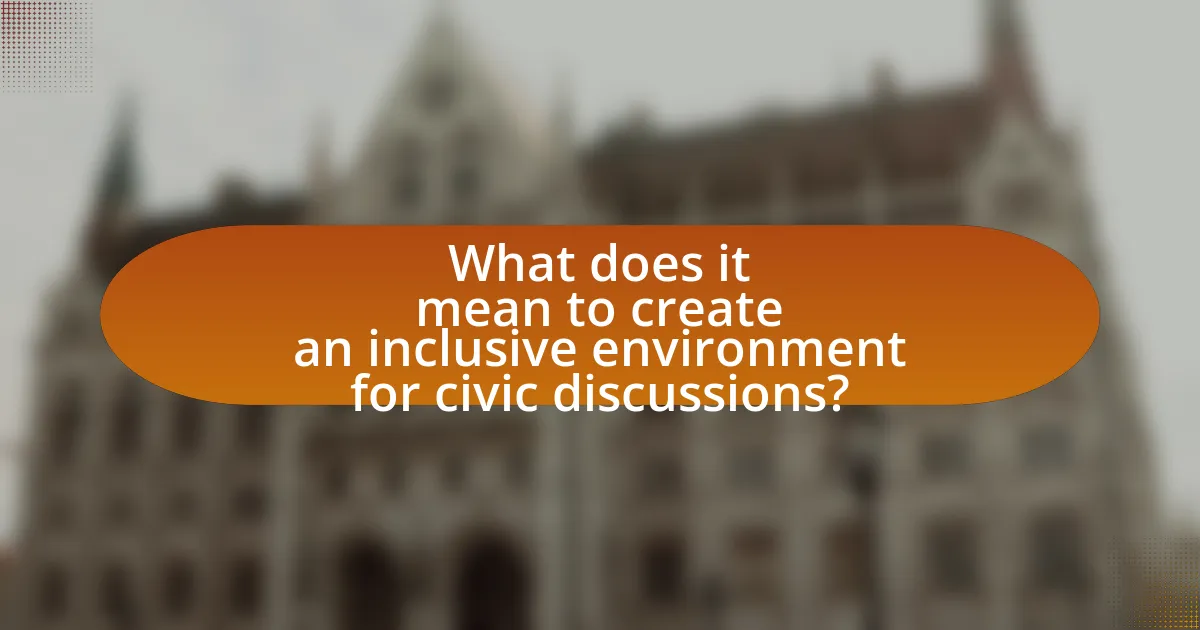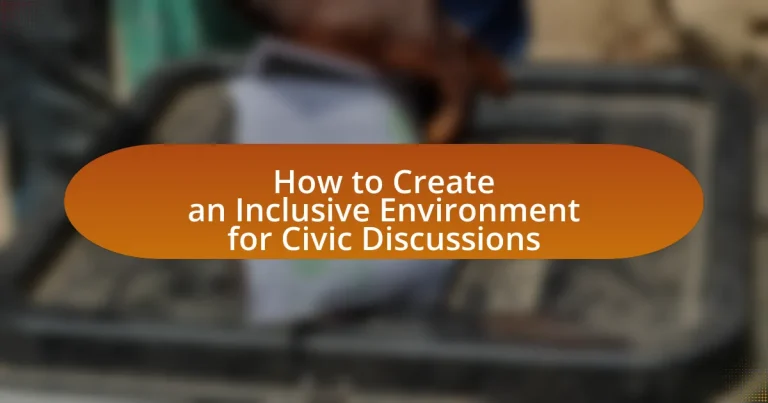Creating an inclusive environment for civic discussions involves fostering a space where diverse voices and perspectives are welcomed and valued. This article outlines the importance of inclusivity in civic engagement, highlighting its impact on community participation, decision-making, and social cohesion. Key principles such as representation, accessibility, respect, and active participation are discussed, along with strategies to overcome challenges like systemic biases and exclusion. The article also emphasizes the role of active listening, empathy, and community involvement in promoting inclusivity, providing actionable steps for individuals and organizations to implement effective practices in civic discussions.

What does it mean to create an inclusive environment for civic discussions?
Creating an inclusive environment for civic discussions means fostering a space where diverse voices and perspectives are welcomed and valued. This involves actively encouraging participation from individuals of varying backgrounds, including different races, genders, socioeconomic statuses, and abilities. Research indicates that inclusive civic engagement leads to more representative decision-making and enhances community cohesion. For instance, a study by the National Civic League found that inclusive practices in civic discussions improve trust in local government and increase public participation rates.
Why is inclusivity important in civic discussions?
Inclusivity is important in civic discussions because it ensures diverse perspectives are represented, leading to more comprehensive and effective decision-making. When various voices, particularly those from marginalized communities, are included, the discussions reflect the needs and concerns of the entire population, not just a select few. Research indicates that inclusive civic engagement can enhance social cohesion and trust in public institutions, as seen in studies by the National Civic League, which highlight that communities with higher levels of inclusivity experience greater civic participation and improved public policy outcomes.
How does inclusivity impact community engagement?
Inclusivity significantly enhances community engagement by fostering a sense of belonging among diverse groups. When individuals feel included, they are more likely to participate in civic discussions and activities, leading to increased collaboration and shared decision-making. Research indicates that inclusive environments can boost participation rates by up to 30%, as seen in studies conducted by the National Civic League, which highlight the correlation between inclusivity and active community involvement. This engagement not only enriches the dialogue but also ensures that a wider range of perspectives is considered, ultimately leading to more effective and representative outcomes in community initiatives.
What are the consequences of exclusion in civic discussions?
Exclusion in civic discussions leads to diminished democratic engagement and a lack of representation for marginalized voices. When certain groups are excluded, their perspectives and needs are overlooked, resulting in policies that do not reflect the community’s diversity. Research indicates that inclusive civic discussions enhance decision-making quality and foster social cohesion, while exclusion can exacerbate social tensions and lead to disillusionment with the political process. For example, a study by the National Civic League found that inclusive practices in civic engagement increase trust in government and community resilience.
What are the key principles of inclusivity in civic discussions?
The key principles of inclusivity in civic discussions are representation, accessibility, respect, and active participation. Representation ensures diverse voices are included, reflecting the community’s demographics and perspectives. Accessibility involves removing barriers to participation, such as providing materials in multiple languages and ensuring venues are physically accessible. Respect fosters a safe environment where all participants feel valued and heard, promoting constructive dialogue. Active participation encourages individuals to engage meaningfully, contributing their insights and experiences. These principles are supported by research indicating that inclusive civic discussions lead to more equitable decision-making and stronger community ties.
How can respect and empathy be fostered in discussions?
Respect and empathy can be fostered in discussions by actively listening and validating others’ perspectives. Active listening involves giving full attention to the speaker, which demonstrates that their thoughts and feelings are valued. Validating perspectives can be achieved by acknowledging the emotions and experiences of others, even if there is disagreement. Research indicates that when individuals feel heard and understood, they are more likely to engage constructively, leading to a more inclusive dialogue. For example, a study published in the Journal of Social Issues highlights that empathetic communication reduces conflict and promotes collaboration in group discussions.
What role does active listening play in inclusivity?
Active listening is essential for fostering inclusivity as it ensures that all voices are heard and valued in discussions. By actively engaging with speakers, individuals demonstrate respect and openness, which encourages diverse perspectives to be shared. Research indicates that environments promoting active listening lead to increased participation from marginalized groups, as they feel acknowledged and understood. For instance, a study published in the Journal of Communication found that active listening practices significantly enhance group cohesion and trust, which are critical components of an inclusive atmosphere.
What challenges exist in creating an inclusive environment?
Creating an inclusive environment faces several challenges, including systemic biases, lack of awareness, and resistance to change. Systemic biases often manifest in organizational structures and cultural norms that favor certain groups over others, making it difficult for diverse voices to be heard. Lack of awareness among individuals about the importance of inclusivity can lead to unintentional exclusion, as people may not recognize their own biases or the barriers faced by marginalized groups. Additionally, resistance to change can arise from individuals or groups who feel threatened by the prospect of altering established norms, which can hinder efforts to foster an inclusive atmosphere. These challenges are supported by research indicating that organizations with diverse teams perform better, yet many still struggle to implement effective inclusivity strategies.
How do biases affect civic discussions?
Biases significantly distort civic discussions by influencing participants’ perceptions and interpretations of information. When individuals hold biases, they tend to favor information that aligns with their pre-existing beliefs while dismissing opposing viewpoints, leading to polarized conversations. Research indicates that confirmation bias, for instance, can result in selective exposure to information, which undermines the quality of civic discourse. A study by the Pew Research Center found that individuals often engage in echo chambers, where they only interact with like-minded individuals, further entrenching their biases and reducing the likelihood of constructive dialogue. This dynamic not only stifles diverse perspectives but also hampers the collective decision-making process essential for a healthy democracy.
What barriers do marginalized groups face in civic engagement?
Marginalized groups face several barriers in civic engagement, including systemic discrimination, lack of access to resources, and social isolation. Systemic discrimination manifests through policies and practices that disproportionately affect these groups, limiting their participation in civic activities. For instance, research by the American Psychological Association highlights that individuals from marginalized communities often encounter obstacles such as voter suppression tactics, which can include strict ID laws and limited polling locations. Additionally, lack of access to resources, such as transportation and information, further hinders their ability to engage in civic processes. Social isolation, often exacerbated by economic disparities, can lead to a lack of community support and networks that facilitate civic participation. These barriers collectively contribute to the underrepresentation of marginalized groups in civic discussions and decision-making processes.
How can we transition from understanding inclusivity to implementing it?
To transition from understanding inclusivity to implementing it, organizations must develop actionable strategies that translate theoretical knowledge into practical applications. This can be achieved by creating specific policies that promote diverse participation, such as establishing guidelines for inclusive language and behavior during discussions. Research indicates that organizations with clear inclusivity policies see a 30% increase in participation from underrepresented groups, demonstrating the effectiveness of structured approaches. Additionally, training programs focused on unconscious bias and active listening can equip individuals with the skills necessary to foster an inclusive environment, further bridging the gap between understanding and implementation.
What strategies can be employed to promote inclusivity in civic discussions?
To promote inclusivity in civic discussions, strategies such as establishing ground rules for respectful dialogue, ensuring diverse representation, and utilizing facilitation techniques can be employed. Establishing ground rules fosters a safe environment where all participants feel valued and heard, which is essential for constructive engagement. Ensuring diverse representation involves actively including voices from various demographics, such as different ethnicities, genders, and socioeconomic backgrounds, which enriches the discussion and reflects the community’s diversity. Facilitation techniques, such as using open-ended questions and encouraging quieter participants to share their perspectives, help to balance participation and ensure that all viewpoints are considered. These strategies are supported by research indicating that inclusive practices lead to more effective and equitable civic engagement outcomes.
How can facilitators encourage diverse perspectives?
Facilitators can encourage diverse perspectives by actively promoting inclusive dialogue and creating a safe space for all participants to share their views. This can be achieved through techniques such as structured turn-taking, where each participant is given equal opportunity to speak, and by using open-ended questions that invite varied responses. Research indicates that inclusive practices, such as ensuring representation from different demographic groups, lead to richer discussions and more innovative solutions (Page, S.E., 2007, “The Difference: How the Power of Diversity Creates Better Groups, Firms, Schools, and Societies”). By implementing these strategies, facilitators can effectively harness the benefits of diverse perspectives in civic discussions.
What tools can be used to ensure all voices are heard?
To ensure all voices are heard, tools such as anonymous surveys, digital platforms for feedback, and facilitated discussions can be utilized. Anonymous surveys allow participants to express their opinions without fear of judgment, increasing the likelihood of honest feedback. Digital platforms, like online forums or social media, provide accessible spaces for diverse voices to share their perspectives. Facilitated discussions, led by trained moderators, ensure that quieter participants have opportunities to contribute, promoting a balanced dialogue. Research indicates that inclusive practices in civic discussions lead to more representative outcomes and increased community engagement.
What specific actions can individuals take to foster inclusivity?
Individuals can foster inclusivity by actively listening to diverse perspectives and engaging in open dialogues. This involves creating safe spaces where all voices are heard, encouraging participation from underrepresented groups, and being mindful of language that may alienate others. Research indicates that inclusive environments enhance collaboration and innovation, as seen in studies by the Harvard Business Review, which found that diverse teams are 35% more likely to outperform their homogeneous counterparts. By implementing these actions, individuals contribute to a more equitable and inclusive civic discussion environment.
How can individuals educate themselves on inclusivity issues?
Individuals can educate themselves on inclusivity issues by engaging with diverse perspectives through reading literature, attending workshops, and participating in community discussions. Research indicates that exposure to varied viewpoints enhances understanding and empathy, which are crucial for fostering inclusivity. For instance, studies show that individuals who participate in diversity training programs report increased awareness of biases and improved interpersonal skills. Additionally, resources such as online courses and podcasts focused on social justice can provide valuable insights into inclusivity challenges and strategies.
What role does community involvement play in promoting inclusivity?
Community involvement is essential in promoting inclusivity as it fosters diverse participation and representation in civic discussions. Engaging various community members allows for a broader range of perspectives, which enhances understanding and empathy among different groups. Research indicates that inclusive community initiatives, such as town hall meetings and collaborative projects, lead to increased social cohesion and trust, as evidenced by a study from the National Civic League, which found that communities with higher levels of civic engagement report greater feelings of belonging and acceptance among residents. This active participation not only empowers marginalized voices but also creates a more equitable environment where all individuals feel valued and heard.
What are some best practices for creating an inclusive environment for civic discussions?
To create an inclusive environment for civic discussions, it is essential to establish ground rules that promote respect and active listening among participants. Ground rules help ensure that all voices are heard and valued, fostering a sense of belonging. Research indicates that inclusive discussions lead to better decision-making and community engagement, as diverse perspectives contribute to more comprehensive solutions. Additionally, providing training on cultural competency and bias awareness equips participants with the skills to engage thoughtfully and empathetically, further enhancing inclusivity.
How can feedback be used to improve inclusivity in discussions?
Feedback can be used to improve inclusivity in discussions by actively soliciting diverse perspectives and addressing any barriers to participation. When participants provide feedback on their experiences, it highlights areas where certain voices may be marginalized or overlooked, allowing facilitators to adjust their approaches. For instance, research shows that inclusive feedback mechanisms, such as anonymous surveys or open forums, can reveal insights about participants’ comfort levels and engagement, leading to more equitable discussion practices. By implementing changes based on this feedback, discussions can become more welcoming and representative of all viewpoints, ultimately fostering a more inclusive environment.
What ongoing efforts are necessary to maintain an inclusive environment?
Ongoing efforts necessary to maintain an inclusive environment include continuous education, active engagement, and policy enforcement. Continuous education involves training programs that raise awareness about diversity and inclusion, ensuring all participants understand the importance of these values. Active engagement requires creating platforms for open dialogue where diverse voices can share their perspectives, fostering a sense of belonging. Policy enforcement ensures that established guidelines against discrimination and harassment are upheld, creating a safe space for all individuals. Research indicates that organizations with strong diversity and inclusion practices see improved collaboration and innovation, highlighting the effectiveness of these ongoing efforts.


